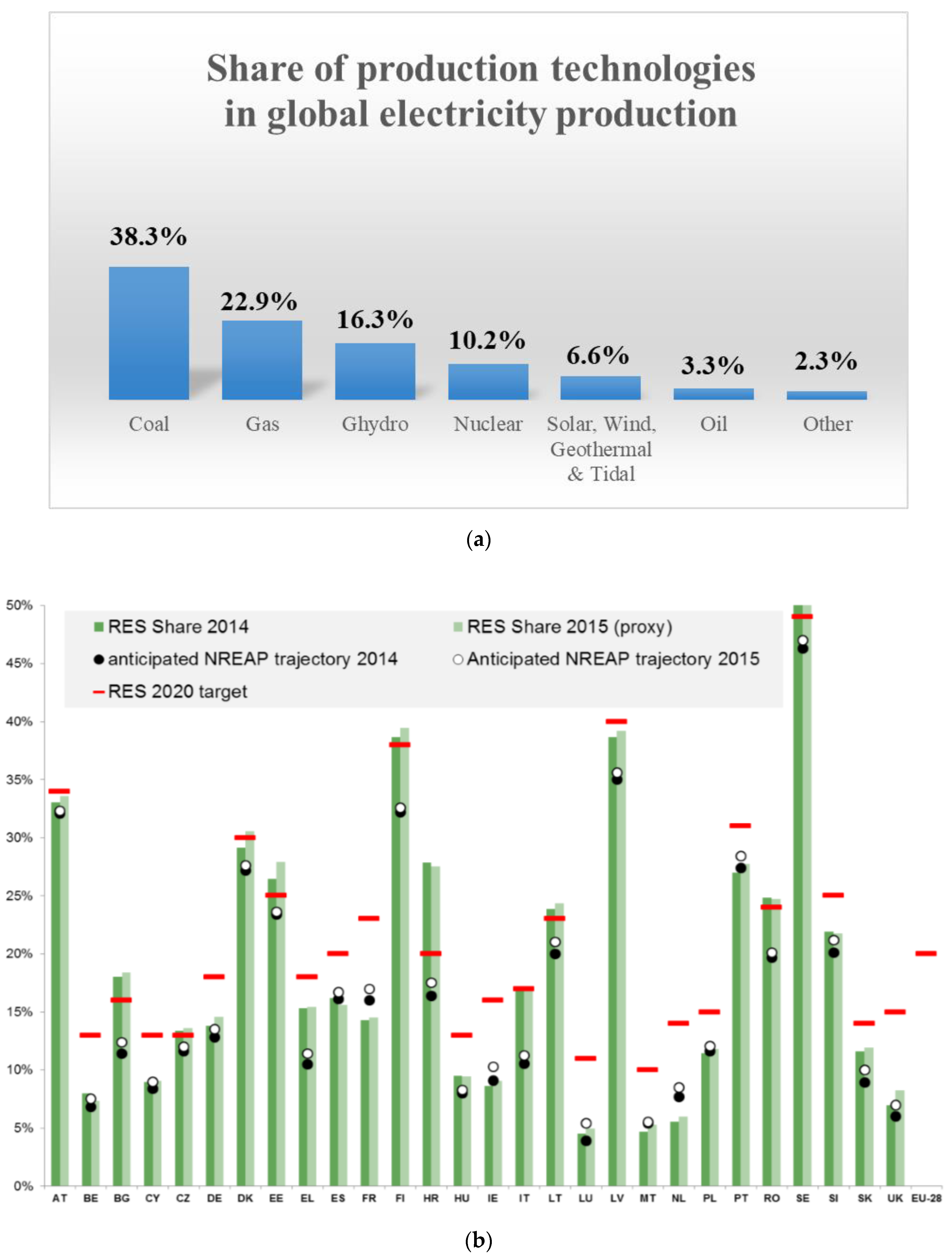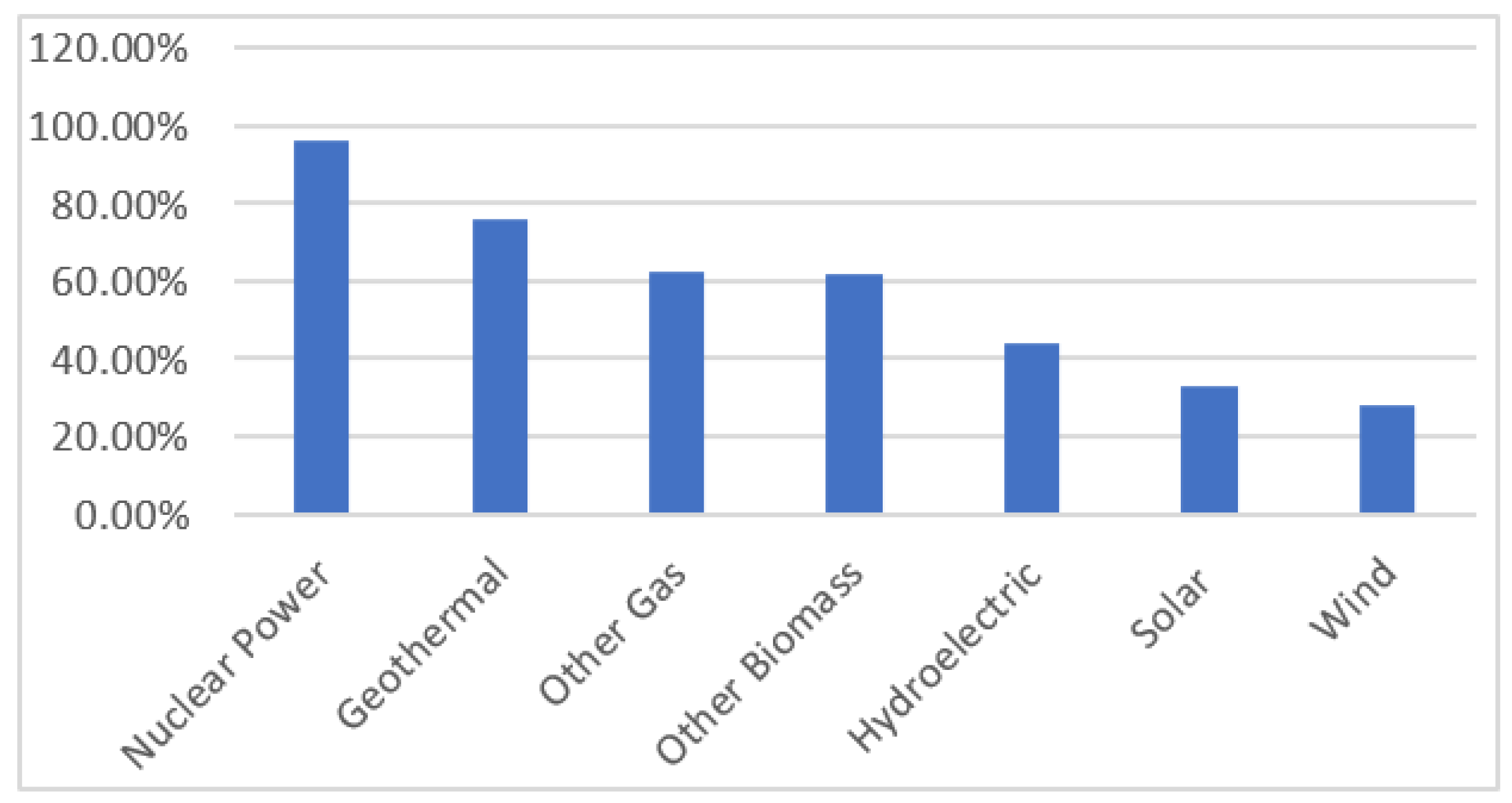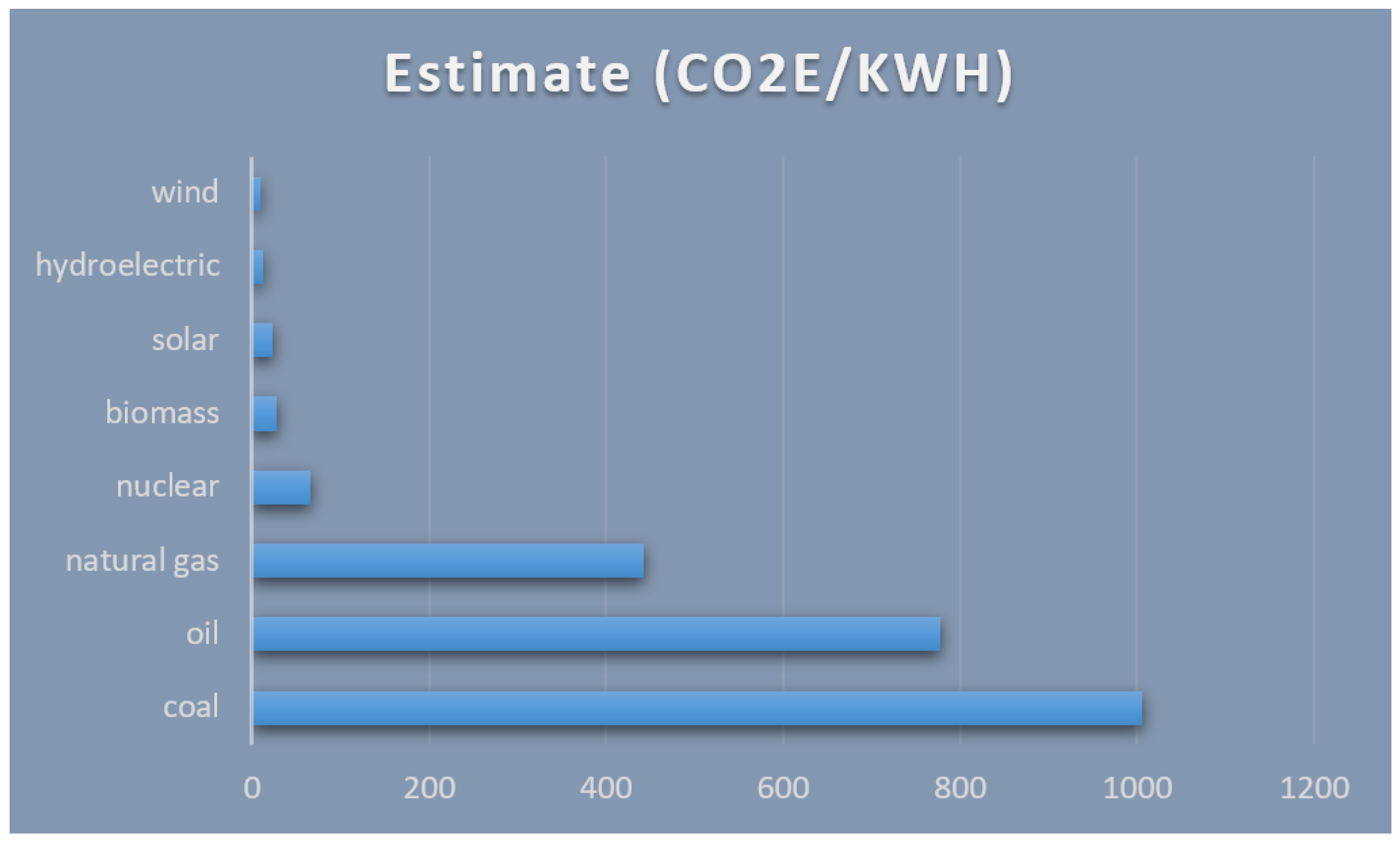The Nuclear Power Dilemma—Between Perception and Reality
Abstract
1. Introduction
2. Economics of Nuclear Power
3. Safety Aspects—An Interdisciplinary View
3.1. Effects of Coal Combustion on the Human Health and Environment
3.2. Effects of Radiation in the Body
3.3. Safety Regulations in the US
3.4. Health Impact of Nuclear Power Accidents
3.5. Safety Measures
- Assessment of natural hazards and margins beyond design basis.
- Periodic safety reviews and evaluation of natural hazards.
- Urgent measures to protect containment integrity.
- Measures to prevent and mitigate accidents resulting from extreme natural hazards.
4. Environmental Impact
4.1. Waste Management
4.2. Green House Gas Emissions
5. Public Perception & Proliferation
5.1. Public Perception
5.1.1. What Is Risk?
5.1.2. What Shapes the Public Opinion on Nuclear Power?
5.2. Nuclear Weapons Proliferation
6. Conclusions
Author Contributions
Funding
Acknowledgments
Conflicts of Interest
References
- IEA. Data & Statistics; IAEA: Wien, Austria, 2019; Available online: https://www.iea.org/data-and-statistics?country=WORLD&fuel=Energy%20supply&indicator=Total%20energy%20supply%20(TES)%20by%20source (accessed on 1 September 2020).
- UN Environment Program (UNEP). Cut Global Emissions by 7.6 Percent Every Year for Next Decade to Meet 1.5 °C Paris Target—UN Report. 2020. Available online: https://www.unenvironment.org/news-and-stories/press-release/cut-global-emissions-76-percent-every-year-next-decade-meet-15degc (accessed on 1 September 2020).
- Nikolić, B.D.; Kegl, B.; Milanović, S.M.; Jovanović, M.M.; Spasić, Ž.T. Effect of Biodiesel on Diesel Engine Emissions. Therm. Sci. 2018, 22 (Suppl. S5), 1483–1498. [Google Scholar] [CrossRef]
- World Nuclear Association. Safety of Nuclear Power Reactors. 2019. Available online: https://www.world-nuclear.org/information-library/safety-and-security/safety-of-plants/safety-of-nuclear-power-reactors.aspx (accessed on 1 September 2020).
- Paraschiv, F.; Erni, D.; Pietsch, R. The impact of renewable energies on EEX day-ahead electricity prices. Energy Policy 2014, 73, 196–210. [Google Scholar] [CrossRef]
- MIT Energy Initiative. The Future of Nuclear Energy in a Carbon-Constrained World. 2018. Available online: https://energy.mit.edu/ (accessed on 1 September 2020).
- Acker, T.L.; Williams, S.K.; Duque, E.P.; Brummels, G.; Buechler, J. Wind resource assessment in the state of Arizona: Inventory, capacity factor, and cost. Renew. Energy 2007, 32, 1453–1466. [Google Scholar] [CrossRef]
- Joskow, P.L.; Parsons, J.E. The economic future of nuclear power. Daedalus 2009, 138, 45–59. [Google Scholar] [CrossRef]
- Stefansson, V. Investment cost for geothermal power plants. Geothermics 2002, 31, 263–272. [Google Scholar] [CrossRef]
- Beyea, J.; Lyman, E.; von Hippel, F.N. Accounting for long-term doses in worldwide health effects of the Fukushima Daiichi nuclear accident. Energy Environ. Sci. 2013, 6, 1042–1045. [Google Scholar] [CrossRef]
- Petti, D.A.; Buongiorno, J.; Parsons, J.E.; Parsons, J. The Future of Nuclear Energy in a Carbon-Constrained World; Massachusetts Institute of Technology Energy Initiative (MITEI): Cambridge, MA, USA, 2018; Available online: http://energy.mit.edu/wp-content/uploads/2018/09/The-Future-of-Nuclear-Energy-in-a-Carbon-Constrained-World.pdf (accessed on 1 September 2020).
- EIA. Electrical Power Monthly. Energy Information Administration. 2020. Available online: https://www.eia.gov/electricity/monthly/epm_table_grapher.php?t=epmt_6_07_b (accessed on 1 September 2020).
- Hagfors, L.I.; Kamperud, H.H.; Paraschiv, F.; Prokopczuk, M.; Sator, A.; Westgaard, S. Prediction of extreme price occurrences in the German day-ahead electricity market. Quant. Financ. 2016, 16, 1929–1948. [Google Scholar] [CrossRef]
- Kiesel, R.; Paraschiv, F. Econometric analysis of 15-min intraday electricity prices. Energy Econ. 2017, 64, 77–90. [Google Scholar] [CrossRef]
- Kremer, M.; Kiesel, R.; Paraschiv, F. Intraday electricity pricing of night contracts. Energies 2020, 13, 4501. [Google Scholar] [CrossRef]
- Friedman, S.M. Three Mile Island, Chernobyl, and Fukushima: An analysis of traditional and new media coverage of nuclear accidents and radiation. Bull. At. Sci. 2011, 67, 55–65. [Google Scholar] [CrossRef]
- Paraschiv, F.; Bunn, D.W.; Westgaard, S. Estimation and Application of Fully Parametric Multifactor Quantile Regression with Dynamic Coefficients; Paper No. 2016/07, SSRN; University of St. Gallen, School of Finance Research: St. Gallen, Switzerland, 2016; Available online: https://ssrn.com/abstract=2741692 (accessed on 1 September 2020).
- Wittenstein, M.; Rothwell, G. Projected Costs of Generating Electricity, 2015th ed.; Organisation for Economic Cooperation and Development (OECD): Paris, France, 2015; Available online: https://www.oecd-nea.org/ndd/pubs/2015/7057-proj-costs-electricity-2015.pdf (accessed on 1 September 2020).
- Lazard Estimates. Levelized Cost of Energy and Levelized Cost of Storage. 2020. Available online: https://www.lazard.com/perspective/lcoe2019/ (accessed on 1 November 2020).
- NuScale. NuScale’s Affordable SMR Technology for All. 2020. Available online: https://www.nuscalepower.com/newsletter/nucleus-spring-2020/featured-topic-cost-competitive (accessed on 1 September 2020).
- CRSP Report. Advanced Nuclear Reactors: Technology Overview and Current Issues. 2019. Available online: https://www.everycrsreport.com/reports/R45706.html (accessed on 1 September 2020).
- Khatib, H.; Difiglio, C. Economics of nuclear and renewables. Energy Policy 2016, 96, 740–750. [Google Scholar] [CrossRef]
- Portugal-Pereira, J.; Ferreira, P.; Cunha, J.; Szklo, A.; Schaeffer, R.; Araújo, M. Better late than never, but never late is better: Risk assessment of nuclear power construction projects. Energy Policy 2018, 120, 158–166. [Google Scholar] [CrossRef]
- Cornell, K. Climate Change and Infectious Disease Patterns in the United States: Public Health Preparation and Ecological Restoration as a Matter of Justice. 2016. Available online: https://mdsoar.org/bitstream/handle/11603/3006/CORNELL_MAESTHESIS%20Edited.docx?sequence=1;CORNELL_MAESTHESIS (accessed on 1 February 2020).
- Singh, A.; Agrawal, M. Acid rain and its ecological consequences. J. Environ. Biol. 2007, 29, 15. [Google Scholar]
- Munawer, M.E. Human health and environmental impacts of coal combustion and post-combustion wastes. J. Sustain. Min. 2018, 17, 87–96. [Google Scholar] [CrossRef]
- PowerTechnology. Fathoming Filtration: Reducing Pollutants in Coal-Fired Power Plants. 2010. Available online: https://www.power-technology.com/features/feature104857/ (accessed on 1 September 2020).
- United States Environmental Protection Agency US EPA. Radiation Sources and Doses. Overviews and Factsheets. 2015. Available online: https://www.epa.gov/radiation/radiation-sources-and-doses (accessed on 1 September 2020).
- Kumar, V.; Abbas, A.K.; Aster, J.C. Robbins Basic Pathology; E-Book; Elsevier: Amsterdam, The Netherlands, 2017; Available online: https://books.google.no/books?hl=en&lr=&id=YYZMDgAAQBAJ&oi=fnd&pg=PP1&dq=Kumar,+V.,+Abbas,+A.+K.,+%26+Aster,+J.+C.+(2017).+Robbins+basic+pathology+e-book.+Elsevier+Health++Sciences.&ots=YjslH1p-wB&sig=bX2CTbFNLmwclveKDJuXdbeA7m4&redir_esc=y#v=onepage&q&f=false (accessed on 1 September 2020).
- United States Environmental Protection Agency US EPA. Nuclear Power Plants. Overviews and Factsheets. 2018. Available online: https://www.epa.gov/radtown/nuclear-power-plants (accessed on 1 September 2020).
- Baba, M. Fukushima accident: What happened? Radiat. Meas. 2013, 55, 17–21. [Google Scholar] [CrossRef]
- Holt, M.; Campbell, R.J.; Nikitin, M.B. Fukushima Nuclear Disaster; Congressional Research Service: Washington, DC, USA, 2012. [Google Scholar]
- Burgherr, P.; Hirschberg, S. Comparative risk assessment of severe accidents in the energy sector. Energy Policy 2014, 74, S45–S56. [Google Scholar] [CrossRef]
- Hirschberg, S.; Spiekerman, G.; Dones, R. Severe Accidents in the Energy Sector; Paul Scherrer Inst: Villigen, Switzerland, 1998. Available online: https://www.osti.gov/etdeweb/biblio/691242 (accessed on 1 September 2020).
- IAEA. The Chernobyl Forum. 2003–2005. Available online: https://www.iaea.org/newscenter/focus/chernobyl (accessed on 1 September 2020).
- Kim, J.; Kim, B.J.; Kim, N. Perception-based Analytical Technique of Evacuation Behavior under Radiological Emergency: An Illustration of the Kori Area. Nuclear Engineering and Technology. 2020. Available online: https://www.sciencedirect.com/science/article/pii/S1738573320308299 (accessed on 1 September 2020).
- Reimer, M.; Hedberg, T.; Eriksson, A. Diskursiv Krishantering: En Studie Om Hur Organisationer Retoriskt Utformar Sina VD-Brev Till Följd Av En Kris. 2019. Available online: https://www.diva-portal.org/smash/get/diva2:1339350/FULLTEXT01.pdf (accessed on 1 September 2020).
- AVSM; Maj Gen Ajay Kumar Chaturvedi. Nuclear Energy in India’s Energy Security Matrix: An Appraisal; Vij Books India Pvt Ltd.: New Delhi, India, 2014; Available online: https://books.google.com/books/about/Nuclear_Energy_in_India_s_Energy_Securit.html?id=RgiqCQAAQBAJ (accessed on 1 September 2020).
- Ten Hoeve, J.E.; Jacobson, M.Z. Worldwide health effects of the Fukushima Daiichi nuclearaccident. Energy Environ. Sci. 2012, 5, 8743–8757. [Google Scholar] [CrossRef]
- Von Hippel, F.N. The radiological and psychological consequences of the Fukushima Daiichi accident. Bull. At. Sci. 2011, 67, 27–36. [Google Scholar] [CrossRef]
- Richter, B. Opinion on worldwide health effects of the Fukushima Daiichi nuclear accident by J.E. Ten Hoeve and M.Z. Jacobson. Energy Environ. Sci. 2012, 5, 8758–8759. [Google Scholar] [CrossRef]
- World Nuclear Performance Report. 2020. Available online: https://www.world-nuclear.org/our-association/publications/global-trends-reports/world-nuclear-performance-report.aspx (accessed on 15 November 2020).
- Vitazkova, J.; Cazzoli, E. Estimate of Consequences from the Fukushima disaster. In Proceedings of the Nordic PSA Conference, Stockholm, Sweden, 5–6 September 2011. [Google Scholar]
- Burgherr, P.; Eckle, P.; Hirschberg, S. Comparative assessment of severe accident risks in the coal, oil and natural gas chains. Reliab. Eng. Syst. Saf. 2012, 105, 97–103. [Google Scholar] [CrossRef]
- Burgherr, P.; Spada, M.; Kalinina, A.; Vandepaer, L.; Lustenberger, P.; Kim, W. Comparative Risk Assessment of Accidents in the Energy Sector Within Different Long-Term Scenarios and Marginal Electricity Supply Mixes. In Proceedings of the 29th European Safety and Reliability (ESREL) Conference, Hannover, Germany, 22–26 September 2019; pp. 1525–1532. [Google Scholar]
- Spada, M.; Paraschiv, F.; Burgherr, P. A comparison of risk measures for accidents in the energy sector and their implications on decision-making strategies. Energy 2018, 154, 277–288. [Google Scholar] [CrossRef]
- Hirschberg, S.; Bauer, C.; Burgherr, P.; Cazzoli, E.; Heck, T.; Spada, M.; Treyer, K. Health effects of technologies for power generation: Contributions from normal operation, severe accidents and terrorist threat. Reliab. Eng. Syst. Saf. 2016, 145, 373–387. [Google Scholar] [CrossRef]
- IAEA. Nuclear Energy Series Status and Trends in Spent Fuel and Radioactive Waste Management; No. NW-T-1.14; IAEA: Wien, Austria, 2018; Available online: https://www-pub.iaea.org/MTCD/Publications/PDF/P1799_web.pdf (accessed on 1 September 2020).
- World Nuclear Association. World Nuclear Power Reactors & Uranium Requirements. 2018. Available online: https://www.world-nuclear.org/information-library/facts-and-figures/world-nuclear-power-reactors-and-uranium-requireme.aspx (accessed on 1 September 2020).
- Organization for Economic Cooperation and Development OECD. Risks and Benefits of Nuclear Energy. 2007. Available online: https://www.oecd-nea.org/ndd/pubs/2007/NDD_2007_%206242-risks_benefits_nuclear_energy.pdf (accessed on 1 September 2020).
- U.S. NRC. Backgrounder on Radioactive Waste. 2015. Available online: https://www.nrc.gov/reading-rm/doc-collections/fact-sheets/radwaste.html#:~:text=Transuranic%20wastes%2C%20sometimes%20called%20TRU,or%20disintegrate%2C%20to%20harmless%20materials (accessed on 1 September 2020).
- Fox, M.H. Why We Need Nuclear Power: The Environmental Case; Oxford University Press: Oxford, UK, 2014; Available online: https://global.oup.com/academic/product/why-we-need-nuclear-power-9780199344574?cc=no&lang=en& (accessed on 1 September 2020).
- IAEA. Nuclear Power and Sustainable Development; IAEA: Wien, Austria, 2016; Available online: https://www-pub.iaea.org/MTCD/Publications/PDF/Pub1754web-26894285.pdf (accessed on 1 September 2020).
- Pehnt, M. Dynamic life cycle assessment (LCA) of renewable energy technologies. Renew. Energy 2006, 31, 55–71. [Google Scholar] [CrossRef]
- Huang, X. Portfolio selection with a new definition of risk. Eur. J. Oper. Res. 2008, 186, 351–357. [Google Scholar] [CrossRef]
- Jacobs, L.; Worthley, R. A comparative study of risk appraisal: A new look at risk assessment in different countries. Environ. Monit. Assess. 1999, 59, 225–247. [Google Scholar] [CrossRef]
- Slovic, P. The psychology of risk. Saúde Soc. 2010, 19, 731–747. [Google Scholar] [CrossRef]
- Zhu, W.; Wei, J.; Zhao, D. Anti-nuclear behavioral intentions: The role of perceived knowledge, information processing, and risk perception. Energy Policy 2016, 88, 168–177. [Google Scholar] [CrossRef]
- Sjöberg, L. Risk perception: Experts and the public. Eur. Psychol. 1998, 3, 1–12. [Google Scholar] [CrossRef]
- Choi, Y.S.; Kim, J.S.; Lee, B.W. Public’s perception and judgment on nuclear power. Ann. Nucl. Energy 2000, 27, 295–309. [Google Scholar] [CrossRef]
- Wiegman, O.; Gutteling, J.M.; Cadet, B. Perception of nuclear energy and coal in France and The Netherlands. Risk Anal. 1995, 15, 513–521. [Google Scholar] [CrossRef]
- Cordoves-Sánchez, M.; Vallejos-Romero, A. Social construction of risk in non-conventional renewable energy: Risk perception as a function of ecosystem services in La Araucanía, Chile. Ecol. Econ. 2019, 159, 261–270. [Google Scholar] [CrossRef]
- Mah DN, Y.; Hills, P.; Tao, J. Risk perception, trust and public engagement in nuclear decision-making in Hong Kong. Energy Policy 2014, 73, 368–390. [Google Scholar]
- Slovic, P.; Flynn, J.; Mertz, C.K.; Poumadere, M.; Mays, C. Nuclear Power and the Public. In Cross-Cultural Risk Perception; Springer: Boston, MA, USA, 2000; pp. 55–102. [Google Scholar]
- Frantál, B.; Malý, J.; Ouředníček, M.; Nemeškal, J. Distance matters. Assessing socioeconomic impacts of the Dukovany nuclear power plant in the Czech Republic: Local perceptions and statistical evidence. Morav. Geogr. Rep. 2016, 24, 2–13. [Google Scholar]
- Veen, T. Unravelling migratory connections: The next level. Mol. Ecol. 2013, 22, 4144–4146. [Google Scholar] [CrossRef]
- Wang, J.; Seoyong, K. Comparative analysis of public attitudes toward nuclear power energy across 27 European countries by applying the multilevel model. Sustainability 2018, 10, 1518. [Google Scholar] [CrossRef]
- Kasperson, R.E. The social amplification of risk and low-level radiation. Bull. At. Sci. 2012, 68, 59–66. [Google Scholar] [CrossRef]
- Soni, A. Out of sight, out of mind? Investigating the longitudinal impact of the Fukushima nuclear accident on public opinion in the United States. Energy Policy 2018, 122, 169–175. [Google Scholar] [CrossRef]
- Gupta, K.; Nowlin, M.C.; Ripberger, J.T.; Jenkins-Smith, H.C.; Silva, C.L. Tracking the nuclear ‘mood’in the United States: Introducing a long-term measure of public opinion about nuclear energy using aggregate survey data. Energy Policy 2019, 133, 1–8. [Google Scholar] [CrossRef]
- Kim, Y.; Kim, W.; Kim, M. An international comparative analysis of public acceptance of nuclear energy. Energy Policy 2014, 66, 475–483. [Google Scholar] [CrossRef]
- Baum, A.; Gatchel, R.J.; Schaeffer, M.A. Emotional, behavioral, and physiological effects of chronic stress at Three Mile Island. J. Consult. Clin. Psychol. 1983, 51, 565–572. [Google Scholar] [CrossRef]
- Fuhrmann, M. Splitting Atoms: Why do countries build nuclear power plants? Int. Interact. 2012, 38, 29–57. [Google Scholar] [CrossRef]
- United Nation Office for Disarmament Affairs UNODA. Treaty on the Prohibition of Nuclear Weapons. Disarmament Treaties Database. 2017. Available online: https://www.un.org/disarmament/wmd/nuclear/tpnw/ (accessed on 1 September 2020).
- Beckjord, E.S.; Ansolabehere, S.; Deutch, J.; Driscoll, M.; Gray, P.E.; Holdren, J.P.; Joscow, P.L.; Lester, R.K.; Moniz, E.J.; Todreas, N.E. The Future of Nuclear Power: An Interdisciplinary MIT Study; Massachusetts Institute of Technology (MIT): Cambridge, MA, USA, 2003. [Google Scholar]
- Frauendorfer, K.; Paraschiv, F.; Schürle, M. Cross-border effects on Swiss electricity prices in the light of the energy transition. Energies 2018, 11, 2188. [Google Scholar] [CrossRef]





| Energy Source | Levelized Cost ($\MWh) |
|---|---|
| Solar PV-Rooftop Residential | 150–227$ |
| Solar PV-Rooftop C&l | 74–179$ |
| Solar PV-Thin Film Utility scale | 29–38$ |
| Wind | 26–54$ |
| Gas peaking | 151–198$ |
| Nuclear | 129–198$ |
| Coal | 65–159$ |
| Gas combined cycle | 44–73$ |
| Annual limit | Total effective dose of ~5 rems (0.05 Sv)—The sum of the deep-dose equivalent and the committed dose equivalent to any individual organ or tissue other than the lens of the eye being equal to 50 rem [0.5 Sv] |
| Annual limits to the lens of the eye, skin, whole body, and skin of the extremities | Lens dose equivalent to 15 rems (0.15 Sv)—A shallow-dose equivalent to 50 rem (0.5 Sv) to the skin of the whole body or to the skin of the extremities |
Publisher’s Note: MDPI stays neutral with regard to jurisdictional claims in published maps and institutional affiliations. |
© 2020 by the authors. Licensee MDPI, Basel, Switzerland. This article is an open access article distributed under the terms and conditions of the Creative Commons Attribution (CC BY) license (http://creativecommons.org/licenses/by/4.0/).
Share and Cite
Paraschiv, F.; Mohamad, D. The Nuclear Power Dilemma—Between Perception and Reality. Energies 2020, 13, 6074. https://doi.org/10.3390/en13226074
Paraschiv F, Mohamad D. The Nuclear Power Dilemma—Between Perception and Reality. Energies. 2020; 13(22):6074. https://doi.org/10.3390/en13226074
Chicago/Turabian StyleParaschiv, Florentina, and Dima Mohamad. 2020. "The Nuclear Power Dilemma—Between Perception and Reality" Energies 13, no. 22: 6074. https://doi.org/10.3390/en13226074
APA StyleParaschiv, F., & Mohamad, D. (2020). The Nuclear Power Dilemma—Between Perception and Reality. Energies, 13(22), 6074. https://doi.org/10.3390/en13226074




